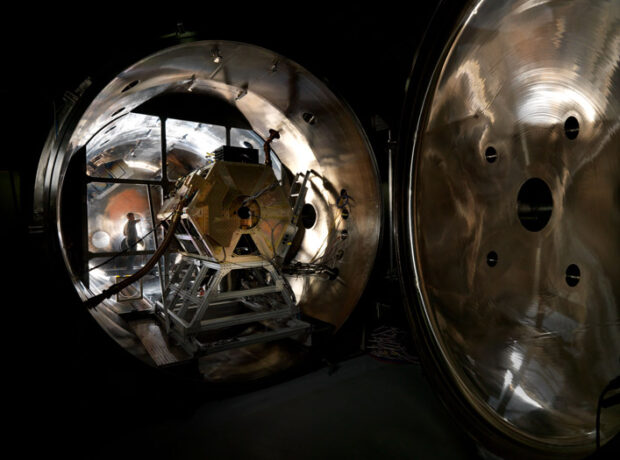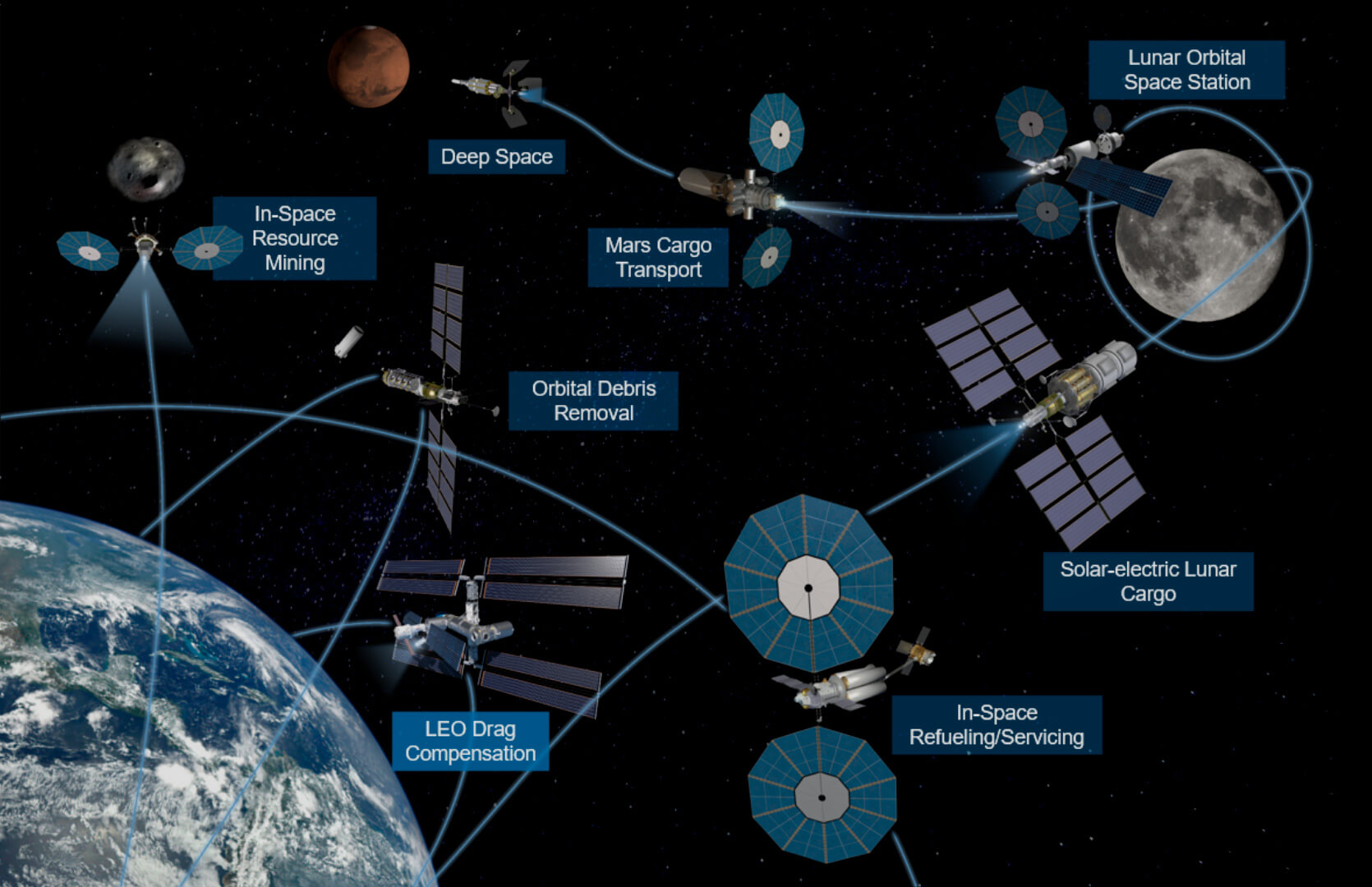The VASIMR® Engine
The Variable Specific Impulse Magnetoplasma Rocket (VASIMR®) engine, is Ad Astra’s flagship project, a disruptive development in the space propulsion status quo. It is the product of more than 40 years of research in plasma physics and electric propulsion, first at the US Department of Energy (DoE) and NASA, and later at Ad Astra Rocket Company.
The VASIMR® engine is a high-power electric rocket engine, designed to provide primary propulsion for a wide range of missions; from economically sustainable logistics operations in cislunar space to high-speed transport in deep space.
In the VASIMR® engine, powerful radiofrequency (RF) waves launched by special antennas (called “couplers”) heat propellant gas, turning it into plasma (a very hot electrically charged gas). A strong, externally applied, magnetic field confines, guides and ultimately accelerates the plasma, letting it escape to provide useful rocket thrust.
The VASIMR® has the potential to transform the way we move around in space, making it more economical, fuel efficient and sustainable and opening a new realm of opportunity for a space-faring economy.

Technical Overview
Electric plasma rockets in general and the VASIMR® engine in particular are able to operate at much higher temperatures than chemical rockets. While conventional chemical rockets operate at thousands of degrees, electric plasma engines work at millions! This is important. The hotter the rocket exhaust, the faster it exits the engine, and the more energy each kg of propellant can deliver. This makes the rocket more fuel efficient. In rocket terminology, this fuel efficiency is expressed as the Specific Impulse (Isp) and has the units of seconds. As a point of comparison, the best chemical rocket available today has an Isp of ~500 s, whereas the VASIMR® engine can reach 5000 s and higher.
The uniqueness of the VASIMR® engine stems from many features of its design. Here are a few:
- No moving parts. Unlike most chemical rockets that need complicated pumps and turbomachinery, the VASIMR®, does not have any moving parts. It is comprised of a two-stage rocket core, each stage with its own Radio Frequency (RF) Coupler. Radio waves are used to make the plasma in the first stage and further heat it in the second stage. A magnetic nozzle accelerates the hot plasma to produce useful thrust.
- Variable Isp and thrust at constant power. A unique feature of the VASIMR® engine, compared to other rockets, is its ability to vary its thrust and specific impulse (Isp), while operating at a fixed total power level. We call this technique “Constant Power Throttling” (CPT), a function similar to the shifting of gears in an automobile. While low gear leads to higher fuel consumption, it provides higher thrust and more muscle to maneuver deep in a gravity well. High gear, on the other hand, reduces the thrust but, increases the fuel efficiency, a better choice during the interplanetary cruise where high thrust is not required. As a car shifts gears to optimize fuel efficiency when moving through hilly terrain, the VASIMR® engine uses CPT for optimal efficiency as it navigates the gravitational hills and valleys of interplanetary space.
Some electric rockets can vary their specific impulse (Isp) by varying their accelerating voltage.
However, in doing so, they must also change the current setting which may adversely affect the efficiency of the discharge. In the VASIMR® engine the variation is accomplished at constant power by changing the fraction of that power going to each stage. For high thrust, power is routed predominantly to the first stage producing more plasma (more thrust) at a lower exhaust velocity (low Isp). For high Isp, less power is fed to the first stage and more to the second, reducing the plasma production but increasing its temperature and hence its exhaust velocity.
- High power density. The full magnetization of both ions and electrons enables the VASIMR® rocket to manage a denser plasma than conventional (DC) electric rockets, such as ion engines or Hall thrusters. This results in a more compact design. Gridded ion engines generally show no magnetization, whereas Hall thrusters exhibit only electron magnetization. The power density of the VASIMR® engine is 6 MW/m2, as compared to .2 MW/m2 for Hall thrusters and .04 MW/m2 for gridded ion engines.
- No electrodes. The VASIMR® rocket has no electrodes imbedded in the plasma that can erode away. The elimination of physical electrodes is of utmost importance for reliability and long life.
- No neutralizer required. Traditional electric rockets, such as ion engines and Hall thrusters are electrostatic accelerators. Positive ions from a plasma are extracted and accelerated through a high voltage gap. The resulting ion beam, however, must be neutralized, lest the rocket become negatively charged by the charge imbalance, forcing the ions back. This neutralization is accomplished by an external “neutralizer gun” which sprays the ion beam with an equal number of negative electrons to make the flow neutral. The VASIMR® rocket requires no such neutralizer. While the ions (being more massive) do provide the bulk of the thrust, both ion and electron populations in the plasma must flow together and any charge imbalance is self-correcting to satisfy a physics requirement that the plasma be substantially neutral.
- Can use multiple propellants. The VASIMR works with many different gases and even mixtures of them. Different propellants are useful for different types of missions. For high power nuclear electric propulsion and interplanetary travel, we might want to use hydrogen (stored as a liquid hydrogen provides very good radiation shielding for humans). For robotic missions with solar-electric power, closer to Earth-Moon environment, Argon is best. The price of the propellant is an important consideration in a space-faring economy supported by electric propulsion. At $1000/kg, Xenon, the propellant of choice for ion engines and Hall thrusters, is too expensive. The VASIMR® engine uses argon, which at $5/kg is considerably more economical.
How it Works
How it works
As stated above, the VASIMR® is a high-power, electric, plasma propulsion system. The mechanics behind how it works are quite simple. A gas – we typically use Argon but have performed successful tests with Helium, Hydrogen, Neon, Krypton, among others – is injected into what we call the “rocket core”. The rocket core comprises 3 stages. In the first, the gas is injected and heated by a Radio Frequency (RF) coupler to produce a plasma. As that plasma moves into the second stage, a second RF coupler energizes it with additional RF power. Finally, the plasma energy is converted to high exhaust velocity in the third stage, the magnetic nozzle and ejected to provide rocket thrust.
One of the exciting parts of working with the VASIMR® engine is the creative innovation involved.
Our engine creates a very hot exhaust. The VASIMR®’s exhaust is anywhere from 1-5 million degrees. Normally those temperatures are impossible to contain in a conventional material duct, however the strong axial magnetic field effectively insulates the plasma from nearby structures. With magnetic insulation there is virtually no limit to how hot we can make the exhaust.
Our engine is an electric engine, meaning it needs an electrical power source to operate.
The VASIMR® can work with many different power sources; for the tests we have performed on the ground we use electricity from the grid, we believe for missions between Low Earth Orbit and the Moon, solar panels would be a practical power option. And as space nuclear electric power matures, we believe that it too could provide a sustainable electric power option for VASIMR®.
Engine Specs
The real beauty of this engine lies in its versatility and scalability. For starters, it is just an engine, meaning it can be placed under any metaphorical “hood.” This allows us to work with many different companies and government agencies. The flexibility to work with different propellants also enables different types of missions with the same engine platform. Moreover, its scalability from 100s of kilowatts to multi megawatts makes it suitable for robotic, solar-electric cargo applications as well as deep-space human transportation with nuclear-electric power.
The following are the specs for a 200kW powered VASIMR® engine using Argon as its fuel.
Defining Characteristics
How We Fit in the Current and Future Space Economy
Many people are unaware of just how much we depend on space and satellites in our every-day lives. Each time you do a search for the nearest café or gas station, or perform a wire transfer, or use an ATM, these actions are being triangulated from space. Not to mention all the technology we use in our everyday life that is a product of space exploration. Technology is advancing at an astounding rate, however our means to move around and stay in space have not advanced much since the 1950s.
There are jobs to be done in space.
Those satellites mentioned earlier need to be maintained. Otherwise, they become space junk. Junk orbiting around the earth at 17,500miles per hour. Satellites are not the only source of space junk, upper stages of chemical rockets remain in orbit for hundreds of years. We have launched so many things in space and yet, have never been able to figure out how to efficiently pick up after ourselves.

There are currently over half a million objects circling the earth at very high speeds.
Being hit by space junk is one of the largest threats to crew members and a spacecraft in orbit. If one of those pieces of space junk were to collide with a major satellite, it could be financially catastrophic and, in some cases, threaten the well-being of entire communities. The VASIMR® engine can help solve this problem and many others that have to do with the logistics of space.
Our current space economy is dominated by chemical propulsion, with a small niche market for low-power electric engines (also known as ion engines). Chemical propulsion is the only way we can get off the earth into space, but once in space, this type of propulsion loses a lot of its efficiency.
Chemical propulsion will still be necessary to support a growing space economy, however if we want to create a sustainable and efficient presence in space we need to develop and implement high-power electric propulsion.
The VASIMR® engine offers an efficient, cost-effective, sustainable, and robust solution for our in-space transportation and logistics needs. It helps open space by providing more capability and potential for future human presence and exploration.
As a high-power electric engine, the scalability of the VASIMR® allows it to work well with both solar and nuclear electric power sources, enabling wide mission versatility from robotic solar-electric cargo flights to fast nuclear-electric human transport to deep space destinations such as Mars and beyond. .
Following our debut space flight, the VASIMR® engine will be poised to support robotic solar-electric logistics missions between Low Earth Orbit and the Moon. As nuclear electric technology matures, we will be able to scale-up to meet it with multi-megawatt engines, this will be crucial to opening human deep-space exploration.
As a species, it is important for our survival to learn how to live in new environments. All species that have made it this far have one thing in common, they adapt. As a growing population of 8 billion, we are outgrowing our planet and causing a great deal of stress on our environment.
We have made it this far because, like other species, we have adapted, we have evolved. We need to continue to do so to insure our survival.

